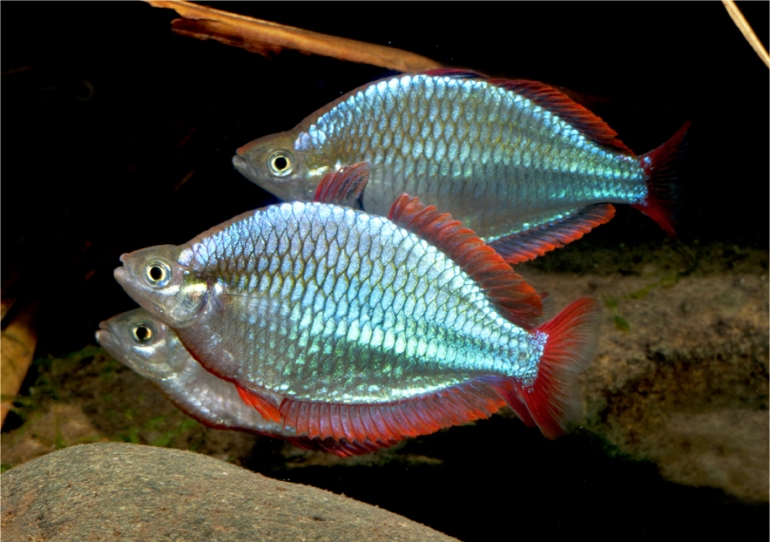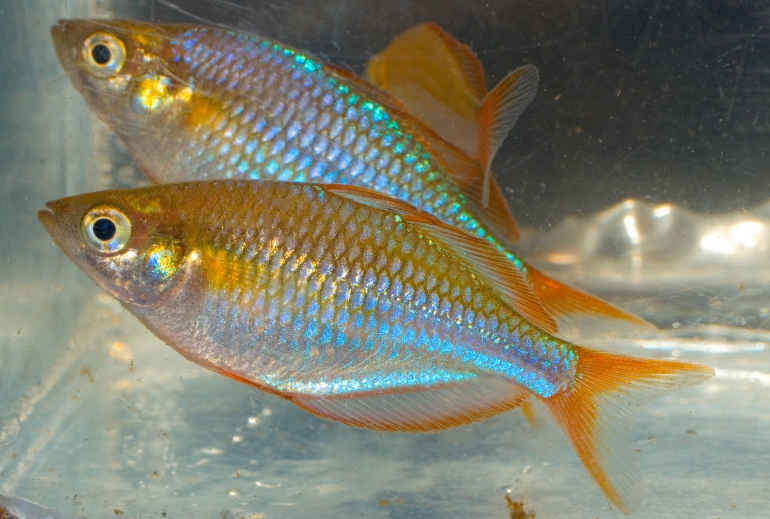|
 |
Melanotaenia praecox - photo© Gunther Schmida |
(Weber and de Beaufort, 1922)
Neon Rainbowfish
Species Summary
Melanotaenia praecox have an intense, bright neon blue body with red dorsal, anal, and caudal fins. They may reach a maximum size of 8 cm, but usually less than 5 cm SL. Males are generally larger and more colourful than the females. The fins of females often show a yellow-orange colour as well.
Melanotaenia praecox is very similar in appearance to Melanotaenia rubrivittata. The two species share a number of similarities including a neon-blue ground colour, brilliant red markings on the median fins, relatively small maximum size (less than about 50 mm SL), overlapping counts for dorsal rays, anal rays, pectoral rays, predorsal scales, and cheek scales, and most morphometric proportions. Genetic results reveal the two species are clearly separable. In addition, M. praecox lacks the characteristic red body stripes of male M. rubrivittata. The males of M. praecox also tend to be deeper bodied than males of M. rubrivittata. There is also a slight difference in snout length with M. praecox generally having a shorter snout than M. rubrivittata. Lastly, M. praecox has fewer lateral scales (usually 29-30 versus 32-33) and frequently has 11 transverse scales (always 10 in M. rubrivittata).
Distribution & Habitat
Melanotaenia praecox was initially collected by the Dutch naturalist W.C. van Heurn in 1910 from a tributary of the Mamberamo River in West Papua. Gerry Allen collected specimens in 1991 from two small localities near the airstrips at Dabra and Iritoi on the edge of the Mamberamo Plains (middle portion of the Mamberamo River). In 2000, he collected more specimens from a tributary of the Tiri River approximately 4 km west of Dabra. The habitat consisted of a small, turbid stream (average 4 m wide and 0.5 m deep with pools to 1.5 m), slow flowing over mud, gravel, and leaf litter and running through closed canopy rainforest. Temperature 24 - 29°C and pH 6.6 - 8.0. In 2008, additional live specimens were collected from near the village of Pagai in the Mamberamo River region by Johannes Graf and Gary Lange.
 |
Melanotaenia praecox (wild caught, Pagai Village) - photo© Gary Lange |
Keeping & Caring
I obtained aquarium-bred specimens of Melanotaenia praecox in August 1994, from a hobbyist in Germany and maintained a small population until around 2000. I successfully bred and raised the fry under the following water conditions: Temperature 26-29°C, pH 7.5-8.0, Alkalinity 30-75 mg/L, Conductivity 410-500 µS/cm, and hardness levels of 80-120 mg/L.
Breeding trials conducted by Said (2008) with M. praecox over a six-month period on the viability regarding the number of eggs, fertilisation rate, hatching rate, the length of incubation period, and survival rate in a seven days rearing period. While observations of growth rate, survival rate, and male percentage were conducted until 6 months old in three replicates. The results reported the average of number of eggs was 27 eggs/spawning, fertilisation rate was 92.93%; hatching rate was 98.18%; length of incubation period was 8 days (7-9), and survival rate in the seven days rearing period was 89.45%, respectively. The growth rate up to 6 months rearing period was 3 cm, while the survival rate was 94 (92-96)%, and the male percentage was 42.58%.
In another study (Radael et al., 2013) M. praecox embryos were examined throughout their development to describe the initial ontogeny. The mean values reported for the physical and chemical parameters of the water from the incubators during the trial period were 28.06 ± 0.49°C for temperature, 6.98 ± 0.15 for pH and 8.78 ± 0.85 mg/L for dissolved oxygen. The diameter of the newly fertilised eggs varied from 0.99 mm to 1.04 mm. The fertilised eggs had a spherical shape, with a translucent corium and yolk sac. The eggs had adhesive filaments in a small area of the corium close to the animal pole that are used for adhesion to the spawning substrate. Eggs that were not fertilised appeared opaque.
Hatching of M. praecox embryos began at 119.50 hours post-fertilisation and continued until 126.53 hours post-fertilisation. The main features of the newly hatched larvae were excellent swimming activity, a reduced yolk sac, mouth movement and an apparently functional digestive system, which is similar to observations of other Melanotaenia species. Newly hatched larvae still contained yolk residue with droplets of oil. Filling of the swim bladder could not be observed in the newly hatched larvae of M. praecox, but sinking did not occur when they stopped swimming. Larvae of M. splendida (Humphrey et al., 2003) fill their swim bladder at the moment of hatching. Newly hatched larvae were very active and possessed excellent swimming ability.
Remarks
Melanotaenia praecox were originally introduced to the aquarium hobby by Charles Nishihira around 1991 who had obtained wild-caught specimens from a local aquarist in Jayapura. Heiko Bleher collected live specimens from an undocumented location in 1992. Fish from all collections have been bred and distributed in the aquarium hobby.
Literature
Allen G.R. (1991) Field guide to the freshwater fishes of New Guinea. Christensen Research Institute, Madang, Papua New Guinea.
Allen G.R. (1992) In Search of the Kamaka Rainbow. Tropical Fish Hobbyist 41(4): 126-145
Allen G.R. & S. Renyaan (2000) Fishes of the Wapoga River System. In: Mack A.L. and L. E. Alonso (eds.) A Biological Assessment of the Wapoga River Area of Northwestern West Papua, Indonesia. RAP Bulletin of Biological Assessment 14, Conservation International, Washington, DC. USA.
Allen G.R., H. Ohee, P. Boli, R. Bawole and M. Warpur (2002) Fishes of the Yongsu and Dabra areas, Papua, Indonesia. In Richards S.J. and S. Suryadi (eds.) A Biodiversity Assessment of Yongsu - Cyclops Mountains and the Southern Mamberamo Basin, Papua, Indonesia. RAP Bulletin of Biological Assessment 25. Conservation International, Washington, DC, USA.
Allen G.R., P.J. Unmack and R.K. Hadiaty (2015) Melanotaenia rubrivittata, A New Species of Rainbowfish (Melanotaeniidae) from Northwestern Papua Province, Indonesia. Fishes of Sahul 29(1): 846-859.
Bleher H. (1995) The Fish of the Century. Fishes of Sahul 9(1): 385-391.
Graf J. (2012) Into the wilds of West Papua in search of the Neon Rainbowfish. AMAZONAS 1(4): 46-52 [English edition]
Radael M.C., L.D. Cardoso, D.R. Andrade, D. Mattos, J.H. Motta, J.V. Manhães and M.V.Vidal (2013) Morphophysiological characterization of the embryonic development of Melanotaenia praecox (Weber & de Beaufort, 1922). Zygote 22(4):1-7.
Said D.S. (2008) Viabilitas reproduksi dan pertumbuhan ikan pelangi mingil Melanotaenia praecox pada habitat terkontrol. Limnotek 15(1) 31-39.
Weber M. and L. F. de Beaufort (1922) The fishes of the Indo-Australian Archipelago. IV. Heteromi, Solenichthyes, Synentognathi, Percesoces, Labyrinthici, Microcyprini. E.J. Brill, Leiden, Netherlands.
Adrian R. Tappin
Updated March, 2016



|
|

